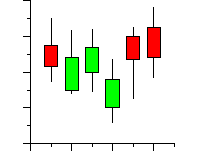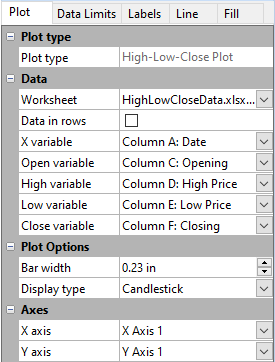Plot Page - High-Low-Close Plots
The high-low-close plot properties Plot page contains the options to change the data file and axes; set data used in the plot; set the bar width; and set the display type. To view and high-low-close plot properties, click on the high-low-close plot in the plot window or Object Manager to select it. Then, click on the Plot tab in the Property Manager. The properties available will be specific to the type of plot.
|
|
|
Change the high-low-close plot properties in the Property Manager on the Plot page. |
Plot Type
The Plot type property displays the type of plot.
Worksheet
Worksheet shows the current data file. To select a different data file, click the existing data file name next to Worksheet. Click on a currently open worksheet or click the Browse option to navigate to a worksheet that is not yet open. Select a different data file in the Open Worksheet dialog, and click the Open button to change the data. The plot automatically updates.
NOTE: The worksheet columns are retained after changing the worksheet. If any of the column options are blank after changing the Worksheet, the previous column does not exist in the new worksheet. Click on the blank option and select the desired column from the new worksheet.
Data
Click on the column name next to the X variable, High variable, Low variable, Open variable, and Close variable fields to change the data used to create the plot. In the list that appears, select the new column. If the first worksheet row contains header information, the header information appears next to the column letter.
The X variable is normally the date for high-low-close plots. This is the column that contains the X axis location for each bar. The High variable is the column that contains the largest value for each row. The High variable contains values greater than the numbers in the Low variable. The Low variable is the column that contains the smallest value for each row. The High variable and Low variable are required. The Open variable displays as a tick mark on the left side of the vertical bar. The Close variable displays as a tick mark on the right side of the vertical bar. If there are no open or close values, choose None for the Open variable and Close variable settings.
Aside from the columns containing data there are two other options for the X variable: row number and sequence number. These options are available in the list that appears before the first column.
- Selecting the Row number option plots the axis with the row numbers used in the Worksheet rows section. For example, if the first row is number two, the axis begins at a value of two.
- The Sequence number option plots the data according to the total number of rows used. The sequence number always begins with the number one regardless of which rows are selected in the Worksheet rows group. Blank lines between rows are ignored when calculating the value. The sequence number increments by one when rows are adjacent or when rows are skipped.
When changing the X variable to date/time data from numeric data, the Use date/time format option for the corresponding axis Tick Labels will automatically be checked to match the new data. When changing the X variable to numeric data from date/time data, the Use date/time format option for the corresponding axis Tick Labels will automatically be unchecked to match the new data.
NOTE: The worksheet columns are retained after changing the worksheet. If any of the column options are blank after changing the Worksheet, click on the blank option and select the desired data. A blank next to column means that the column does not exist in the new worksheet.
Bar Width
Set the width of the open and close tick marks in the Bar width option. Open tick marks are plotted to the left of the horizontal high-low line. Close tick marks are plotted to the right of the horizontal high-low line. The Bar width is a value in page units between 0.0 and 5.0 inches (0.0 and 12.7 centimeters).
Display Type
High-low-close plots can be displayed as lines or as "candlesticks." When selecting Lines, the plot appears as a vertical line between the high and low value with tick marks for the open and close values. When Candlestick is the selected Display type, the plot appears as a line between the high and low value with a box between the opening and closing lines. You must select data for the Open variable and Close variable if you wish to display the high-low-close plot as candlesticks.

|
|
High-low close plots can be displayed as a candlestick plot. The box color depends on whether the closing value is greater or less than the opening value. |
Candlestick Fill
You can choose fill options for the boxes when the Display
type is set to Candlestick.
The fill properties are located on the Fill
page. The Up fill style is the
fill style for when the closing value is greater than the opening value.
This color indicates that the stocks gained this day. The Down
fill style is the fill style for when the closing value is less
than the opening value. This color indicates that the stocks lost value
this day. Click the ![]() next to Up
fill style or Down fill style
to open the fill properties
for each.
next to Up
fill style or Down fill style
to open the fill properties
for each.
Change Axes
Click on the axis name next to the X axis or Y axis fields to change the axes used for the plot. Select another axis name from the list. Alternatively, click Select plots/axis to change the axis used by several plots on a graph at once.
See the Axis - Add to Graph page for information about how to add a new axis to the graph. Once the new axis is added to the graph, it will be available in the X axis or Y axis lists.
